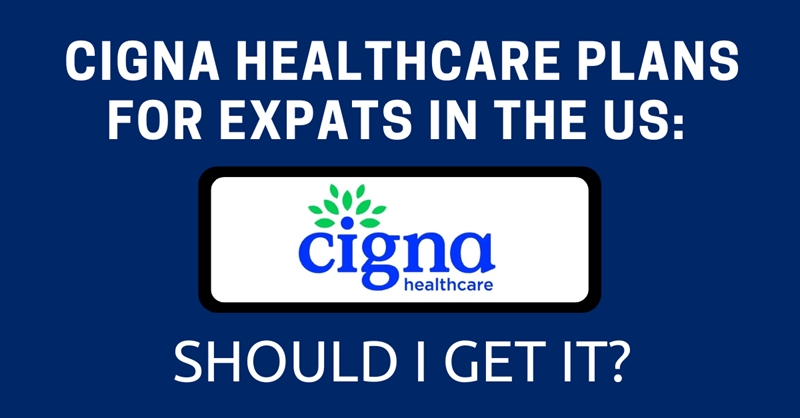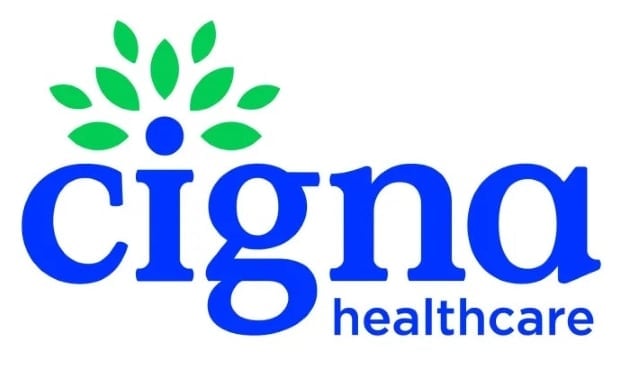
Looking for expat health insurance in the U.S.? Here’s my in-depth review of Cigna Healthcare, including why it works well for expats, what plans to pick, and how much coverage you really need in the U.S.
The USA is the country where I always recommend getting some kind of health insurance. The main reason? Healthcare here is very expensive.
I still remember the first time I came here a decade ago and had a skin allergy. I ended up paying around US$100 just for a few packs of skin cream. And now that I run ExpatDen and have reviewed over 20 insurance providers, I’ve seen a clear pattern. Every plan that includes U.S. coverage is significantly more expensive. That’s because healthcare costs in the U.S. are among the highest in the world.
So, if you’re in the U.S. right now, get health insurance. Otherwise, you might end up paying an arm and a leg when something goes wrong. And not just any plan. You need one that actually covers the kind of expensive treatments you might face here.
Luckily, I’ve found an interesting option for expats: the international insurance plan from Cigna Healthcare.
In this article, I’ll review Cigna Healthcare in detail and share my honest opinion. By the end, you should have a clear idea of whether it’s the right plan for you or not.
This article will take approximately 26 minutes to read. Don't have the time right now? No worries. Email the ad-free version of the article to yourself and read it later!
Disclaimer: This article may include links to products or services offered by ExpatDen's partners, which give us commissions when you click on them. Although this may influence how they appear in the text, we only recommend solutions that we would use in your situation. Read more in our Advertising Disclosure.
Contents
- Key Takeaways
- What Is Cigna Healthcare?
- Why Should the U.S. Expats Choose Cigna Healthcare?
- Downsides of Cigna Healthcare for Expats in the U.S.
- Plans and Coverage
- Optional Coverage
- Area of Coverage
- Exclusions
- Other Benefits of Cigna Healthcare for U.S. Expats
- Waiting Period
- Cigna Healthcare U.S. Claims Process: Is it Easy?
- Which Hospitals in the U.S. Can I Visit with Cigna Healthcare?
- How Much Does Cigna Global Cost in the U.S.?
- Cigna Healthcare Deductible and Cost Share Options
- Which Plan Should I Get?
- Should I Get Cigna Healthcare as an Expat in the U.S.?
- Cigna Healthcare Plan Comparison for Expats in the United States
- Frequently Asked Questions About Cigna Healthcare for U.S. Expats
- Do I need a U.S. Social Security Number to get Cigna Healthcare?
- How quickly does coverage start after I apply?
- What if I need emergency treatment at a hospital that doesn’t work directly with Cigna Healthcare?
- How fast are reimbursements for outpatient claims?
- Do I need pre-authorization for treatment?
- Is maternity coverage included?
- What if I move to a different state?
- Are pre-existing conditions covered?
Key Takeaways
- If you’re in the U.S. and looking for health insurance with good coverage both within the U.S. and internationally, Cigna Healthcare is a solid option.
- Being a U.S.-based insurance company, they have a good track record and a wide range of partnerships with hospitals in the U.S.
- With Cigna Healthcare, you can visit any hospital in the U.S., including top hospitals like Mayo Clinic and Johns Hopkins.
- Cigna Healthcare is also available to everyone. You don’t need a U.S. Social Security Number. That makes it a great option for digital nomads, retirees, or anyone who can’t get an ACA plan.
- All plans come with global coverage. You’re covered in the U.S., your home country (up to 90 days), and when traveling.
- While there are three main plans available, the Gold plan is the best one in my opinion. You get a US$2,000,000 annual limit, which should be sufficient in the U.S.
- Claims are easy. Inpatient is usually billed directly. For outpatient, just upload documents in the app and you’ll get paid back fast.
- Plans start at … You can use this link to get your own free quote within a few minutes.
What Is Cigna Healthcare?
Just a very brief history to tell you more about the company. Cigna Healthcare is part of The Cigna Group, which is one of the biggest health insurance companies in the United States. According to The American Medical Association (AMA), they currently hold about 10–11% of the U.S. commercial health insurance market.
Here’s what this means for you:
- Cigna is completely reliable.
- You don’t need to worry about them going bankrupt anytime soon. In fact, they’ve been in business since the 18th century and are still going strong.

In addition to that, there are a lot of good perks to using a U.S.-based insurance company when you’re in the U.S.
- U.S. regulations: First, they stay up to date with U.S. regulations. The health insurance system here is extremely complicated. Every state has different rules, and those rules keep changing.
- Prior Authorization: Another thing to keep in mind is that hospitals in the U.S. often require prior authorization from your insurance company before they can treat you, even if the plan offers direct billing. This is where having a U.S.-based insurer like Cigna helps. Since they’re in the same time zone and already familiar with how U.S. hospitals work, things tend to move faster and smoother when it matters most.
Why Should the U.S. Expats Choose Cigna Healthcare?
In addition to the 2 points on the US regulations and prior authorization I told you before, based on what I’ve seen, there are many interesting benefits including:
- Customer Support: I really like the customer support from Cigna Healthcare. It’s one of the things that makes their plans stand out for me. They offer several features that make managing your health much more convenient:
- Telemedicine so you can talk to a doctor anytime without leaving your home
- Case management support for serious illnesses like cancer, where you’re assigned a single point of contact to help coordinate treatment and find hospitals
- Crisis Assistance Program, which may help arrange transportation and accommodation in emergency situations
- 24/7 multilingual customer support, available in languages like English, Spanish, French, German, Mandarin, and more
- Coverage: The overall coverage is sufficient for expats, even with the high cost of U.S. healthcare
- International coverage: All plans come with international coverage, so you’re protected not just in the U.S., but also in your home country and while traveling
- Customization: You can customize your plan’s coverage, deductible, and cost-share to match your budget and needs
- Everyone can get it: You don’t need U.S. Social Security Number or permanent residency. This makes it suitable if you can’t get ACA plans, such as digital nomads, retirees, and international students.
In fact, since the plan is quite comprehensive, I can see some expats choosing Cigna Healthcare even if they’re eligible for ACA plans. Cigna Healthcare offers global coverage and more flexibility. They are also much easier to deal with: no government paperwork, no enrollment deadlines, and no need to worry about subsidies or reporting income.
Downsides of Cigna Healthcare for Expats in the U.S.
Cigna Healthcare isn’t perfect.
- Price: The biggest downside is the price. Since it’s not ACA-compliant, you won’t get any government subsidies. On top of that, premiums are generally higher than many other plans.
- Add-on: If you want extra benefits like medical evacuation, outpatient care, dental, or vision coverage, you’ll need to pay more. But that’s pretty standard with most private insurance plans.
- Pre-authorization: Even if a hospital has a direct billing agreement with Cigna Healthcare, some facilities may still require pre-authorization before treatment, just like with other international insurance providers.
Plans and Coverage
Cigna Healthcare offers three core international insurance plans: Silver, Gold, and Platinum.
| Plan | Annual Limit | U.S. Coverage Option |
| Silver | Up to US$1,000,000 | Available |
| Gold | Up to US$2,000,000 | Available |
| Platinum | Unlimited | Available |
All three plans cover:
- Private hospital room
- Cancer care
- Mental and behavioral healthcare
- Transplants and dialysis
- Emergency room treatment
- Global telehealth
- Local and air ambulance services
- Worldwide coverage
The biggest difference between Cigna’s plans is the coverage limit. This matters a lot for expats in the U.S. where healthcare costs can be extremely high.
Silver Plan
The Silver plan is the standard plan for Cigna Healthcare and comes with the following key coverage:
- Annual limits: up to US$1,000,000
- Emergency room treatment: up to US$500
- Advanced medical imaging (MRI, CT, PET): up to US$10,000
- Inpatient mental health: up to US$5,000 (30-day limit)
- Rehabilitation: up to US$5,000 (30-day limit)
While the annual limit may sound high, it’s actually not always enough for the U.S. Remember, healthcare here is among the most expensive in the world. According to debt.org, a single heart transplant can cost over US$1.3 million.
So, I’d say this:
- If you’re young, healthy, or staying in the U.S. short-term and just need basic protection, the Silver plan might be enough.
- But if you want peace of mind and don’t want to worry about hitting your coverage limit during a serious illness or emergency, it’s better to go with a higher-tier plan like Gold or Platinum.
Gold Plan
The Gold plan is the plan I recommend for expats in the U.S. since the annual limit is 2 times higher than the Silver plan. Here’s what included:
- Annual limit: up to US$2,000,000
- Emergency room treatment: up to US$1,000
- Advanced medical imaging (MRI, CT, PET): up to US$15,000
- Inpatient mental health: up to US$10,000 (60-day limit)
- Rehabilitation: up to US$10,000 (60-day limit)
- Inpatient maternity and newborn care: covered
- Cancer care: covered in full
- Pandemic-related care and vaccines: covered
In addition to the higher limit overall, you can now get maternity coverage. However, there are some scenarios where the US$2,000,000 annual limit from the Gold Plan isn’t enough, like months of hospitalization in the ICU.
But it’s not common though.
You can use this link to get a free quote from the Gold plan.
Platinum Plan
If you want complete peace of mind and don’t want to worry about hitting coverage limits, the Platinum plan is the way to go. It offers unlimited annual coverage, so no matter what happens, you’re covered.
Here’s what’s included:
- Annual limit: unlimited
- Emergency room treatment: up to US$2,000
- Advanced medical imaging (MRI, CT, PET): covered in full
- Inpatient mental health: covered in full (up to 90 days)
- Rehabilitation: covered in full (up to 90 days)
- Inpatient maternity and newborn care: covered
- Cancer care: covered in full
With this plan, you can go to virtually any hospital in the U.S., even prestigious ones like Mayo Clinic, Cleveland Clinic, Johns Hopkins Hospital, or Massachusetts General Hospital, without having to worry about the bill.
Optional Coverage
In addition to the coverage you get from the main plans, there are four other optional coverage you can choose.
In this section, I’m going to tell you what they are and whether or not you should get it. I also use the limit from the Gold plan as an example since that’s the plan that I think it’s best for expats in the U.S.
Outpatient Treatment
The main Cigna Healthcare plans primarily cover you when you are hospitalized, with a few exceptions like MRIs or inpatient mental healthcare. However, they don’t cover a doctor’s visit or treatment unless you’re admitted to a hospital. If you want Cigna Healthcare to pay for non-hospital care, you need to include the Outpatient Treatment add-on.
This add-on covers general and specialist consultations, diagnostic tests such as blood tests and X-rays, hearing aids, outpatient rehabilitation, and pre-natal care.
Coverage includes:
- General and specialist consultations
- Diagnostic tests and imaging (e.g., blood tests, X-rays)
- Hearing aids
- Outpatient rehabilitation
- Pre-natal care
Limits (Gold plan):
- Annual limit: US$25,000
- Consultations: US$5,000
- X-rays and diagnostic tests: US$5,000
- Outpatient rehabilitation: US$7,500
Should you get it? In my opinion, yes. The cost of outpatient care in the U.S. is high and unpredictable, even a simple consultation or test can be expensive. The annual limit of US$25,000 should be enough for most expats out-patient treatment.
Evacuation and Repatriation
The main Cigna Healthcare plans already include local road and air ambulance services within your area of coverage.
However, if you want broader protection, such as being transported to another country for better treatment or returning home after a serious medical event, you’ll need to add the Evacuation and Repatriation benefit.
This add-on provides emergency transportation to the nearest adequate medical facility or to your home country when local care isn’t available.
The add-on also comes with Crisis Assistance Plus. This crisis support is particularly noteworthy. For example, in case of a serious situation like a terrorist attack, natural disaster, or other crisis events, you can contact Cigna Healthcare, and they may help arrange for transportation and accommodation. It’s a benefit that I rarely see in other most insurance plans.
Coverage includes:
- Medical evacuation by air or ground
- Repatriation to your home country when medically necessary
- Compassionate travel for close family members
- Temporary accommodation and living allowance
- Crisis Assistance Plus in emergency situations like terrorism or civil unrest
Limits (Gold plan):
- Compassionate trips: Up to US$1,800 per trip (maximum 5 trips)
- Daily living allowance: US$230 per day for up to 10 days per trip
Should you get it?
That totally depends on you. If you live in or frequently travel to remote areas, or simply want the option to be treated or return home during a major emergency, it can be a valuable addition.
If you’re based in a major U.S. city with quality medical facilities nearby and don’t travel much, you might not need it. The Crisis Assistance Plus feature is a strong bonus and adds an extra layer of security not found in many other plans.
Health & Wellbeing
The Health & Wellbeing add-on focuses on preventive care and mental health support, two areas not included in Cigna Healthcare’s core plans. It covers routine physical exams, cancer screenings, foot care, and mental health counseling, both in-person and through telehealth.
One of the main benefits that I really like from this add-on is the ability to access face-to-face counseling sessions for mental health. It can be especially important when living in the U.S., where the mental health system can be difficult to navigate and expensive without insurance.
In fact, according to the Peterson-KFF Health System Tracker, many Americans delay or skip mental health care due to high costs, especially those without insurance.
Coverage includes:
- Routine physical exams
- Cancer screenings (cervical, prostate, breast)
- Foot care (up to 5 visits per year)
- Mental health support
Limits (Gold plan):
- Health check-up: Up to US$650 per visit
- Mental health: Up to 20 sessions per year with a specialist
Should you get it?
It’s totally optional. But if you like to get annual health checkups and want a plan that encourages you to keep doing it, this is a good way to make it part of your routine since you already pay for it.
The health checkup benefit is generally enough for annual health checkups in the U.S. However, please note that it may not be enough for a comprehensive check-up.
Vision and Dental
The Vision and Dental add-on helps reduce the cost of routine eye and dental care for basic services like cleanings, fillings, and eye exams.
Vision:
- Eye test: Up to US$130
- Spectacles: Up to US$250
Dental:
- Annual limit: Up to US$2,000
- 40–80% of treatment costs covered, depending on the procedure
Should you get it? I don’t think so. In fact, I never think vision and dental coverage from insurance plans is that good. But others may think differently, especially if they prefer to have at least some coverage for routine care.
Area of Coverage
When you apply for the Cigna Healthcare plan with U.S. coverage, here’s what you get:
- Full coverage in all states across the United States
- Worldwide coverage, except in a few countries listed below
Home country coverage for up to 90 days per policy year
Here’s what this means for you: you can get health coverage in most parts of the world. It also allows you to fly home and receive treatment there, which can be a great option if you prefer getting care in a familiar environment.
While some countries are not covered by Cigna Healthcare, such as Iran, Syria, North Korea, Cuba, Venezuela, and others, these are places most people don’t typically visit unless for specific reasons.
Exclusions
Like all insurance providers, Cigna Healthcare has a list of exclusions, things they won’t cover under any plan. In my opinion, most of these are pretty standard and you’ll find them with nearly every private health insurance provider.
Common exclusions include:
- Self-inflicted injuries
- Pre-existing conditions*
- Addiction or alcohol-use disorder treatment
- Elective cosmetic procedures
- Food supplements
*One benefit of Cigna Healthcare when it comes to pre-existing conditions is that they help you maintain the below conditions where most other insurance providers just reject them outright. I see it as one of Cigna’s strong points.
- Hypertension
- Type 2 diabetes
- Glaucoma
- Arthritis
- joint or back pain
- Osteoporosis / osteopenia
Anyway, when you sign up for the Cigna Healthcare plan (or any other insurance provider), you’ll need to fill out a health declaration form. It’s best to be completely honest and disclose everything in full. Because if you don’t, they’ll find out anyway and reject your claim.
Other Benefits of Cigna Healthcare for U.S. Expats
I think Cigna Healthcare is trying to be more than just an insurance provider that pays your hospital bills. They keep adding extra services to make your overall healthcare experience more comfortable, things that many other providers don’t offer.
Case Management Support
Like what I mentioned before, if you’re dealing with a complex medical issue, like cancer, Cigna Healthcare offers case management support. Their team helps coordinate appointments, treatments, and follow-up care, which can reduce a lot of stress and confusion when navigating the U.S. healthcare system.
Global Telehealth
You can speak to licensed doctors via phone or app. You can even get prescriptions through this service, which is especially convenient for common, non-emergency issues like flu symptoms, rashes, or minor infections. It saves you a trip to the clinic.
Cigna Wellbeing App
The Cigna Wellbeing App gives you tools to track your health, submit your claims, schedule virtual consults, and access wellness coaching programs. In my opinion, only big international providers offer this level of service.
Waiting Period
The biggest waiting period you should be aware of is for preventive cancer surgery, which has a 12-month waiting period. However, it’s important to note that cancer care itself is fully covered from day one, with no waiting time required. So if you’re diagnosed with cancer, treatment is included immediately.
Here are some other common waiting periods under the plan:
- 3 months: Preventive dental care
- 12 months: Maternity and major dental procedures
- 18–24 months: Orthodontics, obesity treatment, and infertility treatment (Platinum plan only)
Overall, these waiting periods are fairly standard across the industry.
Cigna Healthcare U.S. Claims Process: Is it Easy?
Yes, overall the claims process with Cigna Healthcare in the U.S. is simple.
- Inpatient care: For inpatient care, most hospitals in the U.S. will bill Cigna directly, so you usually won’t need to pay anything upfront or deal with paperwork.
- Outpatient care: You’ll need to submit your claim through the Cigna Healthcare app. Just upload the medical certificate and receipts, and you can typically expect reimbursement within 5 working days once all documents are received.
It’s a good practice to contact Cigna Healthcare first before undergoing any major treatment. Getting prior authorization helps confirm that your treatment is covered under your plan. Cigna Healthcare may also be able to recommend hospitals and doctors in your area.
Important: It’s good to remind you again that U.S. hospitals often contact the insurer directly to confirm coverage again before proceeding with treatment. This process usually happens behind the scenes, so you might not even notice it. Since Cigna Healthcare is based in the U.S., they can handle these pre-approvals quickly, and most hospitals are already very familiar with working with them, which helps speed things up.
Which Hospitals in the U.S. Can I Visit with Cigna Healthcare?
Since Cigna Healthcare is an insurance company from the USA, it has a wide range of hospital partners in the U.S. While I can’t list them all due to the large number, I did some spot checks. For example, in Seattle, Cigna Healthcare is partnered with all the leading hospitals there, including Swedish Medical Center, Virginia Mason Medical Center, and University of Washington Medical Center.
In the case of Houston, I also found Houston Methodist Hospital and Baylor St. Luke’s Medical Center, which are also leading hospitals there.
In rare cases where you go to a hospital that’s not within their network, it’s still possible to visit those hospitals. Just contact Cigna Healthcare in advance. If it’s a hospitalization, Cigna Healthcare may be able to arrange direct billing. If it’s outpatient treatment, you can file a claim later.
How Much Does Cigna Global Cost in the U.S.?
The price example here is for a 40-year-old male:
- The Silver plan costs US$383.66 per month. This includes U.S. coverage and a US$750 deductible, but doesn’t cover outpatient treatment.
- If you want better benefits, the Gold plan costs US$519.91 per month, using the same deductible.
While the price may seem high. especially if you come from a country with free or low-cost public healthcare, it’s actually quite reasonable by U.S. standards. Healthcare in the U.S. is among the most expensive in the world, and insurance prices reflect that.
To put things in context, let’s look at official data. According to the CMS 2024 Open Enrollment Report, which shows nationwide data on health insurance enrollment and pricing for plans sold on the federal marketplace, the average monthly premium for a Silver plan is about US$477. That means:
- Cigna’s Silver plan is roughly US$93 cheaper than the national average.
- Even the Gold plan is more affordable than many marketplace Gold plans, which often cost over US$560 per month.
These are prices without any government subsidies. So, if you don’t qualify for financial assistance, Cigna Healthcare’s pricing can be a good deal, especially since it also comes with international coverage and access to private hospitals both in the U.S. and abroad.
Note: This is just an example. Your actual premium will depend on your age, health, coverage area, plan level, and other factors. The best way to find out your specific cost is to get a quote directly from the Cigna Healthcare website. You can use this link to get it.
Cigna Healthcare Deductible and Cost Share Options
There are both deductible and coinsurance (cost-share) options available to customize your plan to match your budget.
- Deductible options: From $375 to $10,000
- Coinsurance (cost-share): Choose between 10%, 20%, or 30%
The higher the deductible and coinsurance, the lower your premium. If you want more coverage and less out-of-pocket cost when using the insurance, go with lower numbers.
Which Plan Should I Get?
I recommend starting with the Gold plan. While it’s more expensive than the Silver plan but gives you twice the annual coverage limit, US$2,000,000. That makes a big difference in the U.S. where healthcare costs can add up fast. It also includes maternity coverage and is a better fit if you have a family.
The Silver plan is okay if you’re young, healthy, and only plan to keep the insurance for a few years. Its US$1,000,000 annual limit is usually enough unless you run into something major like a heart transplant or intensive cancer treatment.
As for the Platinum plan, you probably won’t need it. It’s rare for medical bills to go beyond US$2,000,000 in a year, even in the U.S. But if you have the budget and want full peace of mind, with the insurer covering pretty much everything, then go for it.
Should I Get Cigna Healthcare as an Expat in the U.S.?
In general, yes. Cigna Healthcare is a solid choice if you’re an expat living in the U.S., especially if you can’t get a subsidized plan through the ACA. It’s also a good option if you:
- want international coverage
- want the freedom to visit any hospital in the U.S. without worrying about networks
- value having personal support from your insurance provider
- prefer a dedicated contact who can assist you when you’re sick
That said, Cigna Healthcare may not be for you if you’re on a budget.
- It’s not the cheapest plan available
- If you have a Social Security Number, you may qualify for more affordable plans through the ACA marketplace
Want to see how much it would cost for you? Get a free quote here.
Cigna Healthcare Plan Comparison for Expats in the United States
Here’s Cigna Healthcare health insurance comparison table for expats in the U.S.
| Feature / Plan | Silver | Gold | Platinum |
| Annual Limit | US$1,000,000 | US$2,000,000 | Unlimited |
| Geographic Coverage | Worldwide (area selectable) | Worldwide (area selectable) | Worldwide (area selectable) |
| Hospital Room Type | Private | Private | Private |
| Hospitalization (Inpatient) | Yes | Yes | Yes |
| Outpatient Care | Optional Add-on | Optional Add-on | Optional Add-on |
| Mental Health Coverage | Yes (Basic: up to US$5,000) | Yes (Enhanced: up to US$10,000) | Yes (Maximum: up to 90 days) |
| Maternity Coverage | No | Yes (with optional add-on) | Yes (with optional add-on) |
| Newborn Care | No | Yes (US$25,000 limit) | Yes (up to US$156,000) |
| Road and Air Ambulance | Yes | Yes | Yes |
| Telehealth Consultations | Yes | Yes | Yes |
| Best For | Young and healthy individuals | Everyone | Those who want to get a peace of mind |
Frequently Asked Questions About Cigna Healthcare for U.S. Expats
Do I need a U.S. Social Security Number to get Cigna Healthcare?
No, you don’t need it. Basically, every expat in the U.S. can get it.
How quickly does coverage start after I apply?
It starts immediately after your application is approved. You can also choose your coverage start date. Please note that there’s a waiting period for some treatments like preventive cancer surgery and maternity coverage.
Also, based on my conversations with various brokers, people usually spend around 1 to 2 months to complete the application.
What if I need emergency treatment at a hospital that doesn’t work directly with Cigna Healthcare?
If this happens, you have two choices. You can either pay out of pocket and make a claim later, or contact Cigna Healthcare directly or ask someone to do it on your behalf. Cigna Healthcare may be able to pay the hospital directly, even if the hospital isn’t in-network.
How fast are reimbursements for outpatient claims?
It’s usually within 5 working days after Cigna Healthcare receives all required documents from you.
Do I need pre-authorization for treatment?
Not always. For general sickness or emergency situations, you don’t need it. However, if it’s a planned treatment or if you know it’s something serious, it’s better to contact Cigna Healthcare first. The same process applies to other insurance providers.
Is maternity coverage included?
It’s only available on the Gold and Platinum plans. Please note that there’s a 12-month waiting period.
What if I move to a different state?
It’s no problem at all since the plan comes with nationwide coverage.
Are pre-existing conditions covered?
No, they’re not. However, Cigna Healthcare helps you manage certain conditions like high blood pressure, Type 2 diabetes, glaucoma, arthritis, back or joint pain, and osteoporosis. This is quite generous since most international providers just reject them outright.
Disclaimer:This article is based on my in-depth research, including a thorough review of Cigna Healthcare’s policy documents and direct communication with their team to verify key details. However, the information provided here is a summary meant to make things easier to read and understand. I can’t include every detail from the full policy, as that would make the article too long and overwhelming. While I’ve done my best to ensure accuracy, I can’t guarantee that everything is 100% correct or up to date. To be sure about your coverage, it’s always best to read the full policy yourself or get written confirmation directly from a Cigna Healthcare representative.





